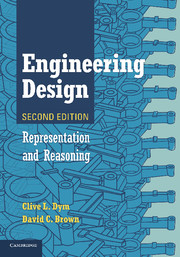Book contents
- Frontmatter
- Contents
- Preface
- Preface to the First Edition
- Acknowledgments
- 1 Framing the Issues
- 2 Engineering Design
- 3 Characterizing the Design Process
- 4 Taxonomies of Engineering Design
- 5 Representing Designed Artifacts
- 6 Representing Design Processes
- 7 Where Do We Go from Here?
- References Listed in First Edition
- New References
- Index
3 - Characterizing the Design Process
Published online by Cambridge University Press: 05 June 2012
- Frontmatter
- Contents
- Preface
- Preface to the First Edition
- Acknowledgments
- 1 Framing the Issues
- 2 Engineering Design
- 3 Characterizing the Design Process
- 4 Taxonomies of Engineering Design
- 5 Representing Designed Artifacts
- 6 Representing Design Processes
- 7 Where Do We Go from Here?
- References Listed in First Edition
- New References
- Index
Summary
Having offered our own definition of engineering design, we now go on to study design as an activity – that is, the process of design. In this chapter, we review some of the established models of the design process. Then we go on to describe more recent articulations, some of which are rooted in the AI-based ideas mentioned earlier. Parts of the discussion may seem vague or abstract because we are trying to describe a complex process by breaking it down into smaller, more detailed pieces, but we are not going to produce a detailed cookbook that must be followed in order to complete a design. We are simply trying to picture, in words and diagrams, what is going on in our head when we are doing design.
Dissecting the Design Process
We start by looking back at the questions we asked (and others that we might have but did not) in our ladder-design exercise. In so doing, we find that we can decompose or break down the process into a sequence of steps by extracting and naming some of those steps. For example, when we ask, “How much weight should a safe ladder support?” and “For what purposes is the ladder to be used?,” we are
clarifying the client's requirements.
- Type
- Chapter
- Information
- Engineering DesignRepresentation and Reasoning, pp. 20 - 38Publisher: Cambridge University PressPrint publication year: 2012



